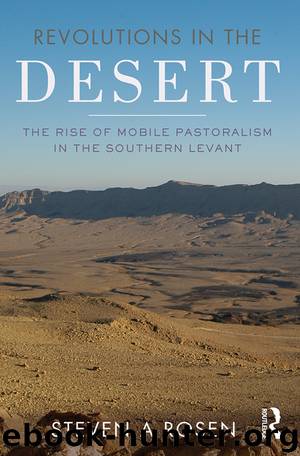Revolutions in the Desert by Rosen Steven;

Author:Rosen, Steven;
Language: eng
Format: epub
Publisher: Routledge
The elaborate ceramic assemblages of the late Pottery Neolithic Qatifian culture (ca. 5000 BCE) of the northwestern Negev (Abadi-Reiss 2009; Gilead 1990) did not penetrate farther south than the dunes of the western Negev. The distinctive Ghassul-Beersheva Chalcolithic ceramic assemblages, including pithoi, basins, v-shaped bowls of various sizes, cornets, and churns, penetrated only slightly farther south, to the Nahal Sekher area (Gilead and Goren 1986), Wadi Zalzal Cave (Cohen 1999:20), and the Dead Sea area, Nahal Mishmar or Ein Gedi (e.g., Gilead 1988). Cohen (1999:15–36) dates some sixteen surveyed sites to the Chalcolithic period in the Central Negev (covering an area of ca. 8000 km2). However, the primary index fossil seems to be axes/adzes, not pottery, and the distinction between Ghassulian and Timnian is not made. Most of the sites seem to be Timnian. The absence of ceramic assemblages attributable to either variants of the Qatifian or the Ghassul-Beersheva complex in Wadi Feinan,11 in spite of the strong evidence linking these copper sources to the copper objects of Ghassul-Beersheva, remains a conundrum, one solution to which would be the Timnians as metal traders (e.g., Tadmor et al. 1995). The Timnian site of Nahal Tsafit (Rosen 2013), halfway on the road between Beersheva and Feinan, with basalt-tempered pottery (undoubtedly from Feinan), supports such an interpretation.
The first real ceramic assemblages in the south, as opposed to small sets of nondescript sherds, appear around the middle of the 4th millennium BC (calibrated). Thus at Serabit el Khadim (Beit-Arieh 1980),12 a large number of nawamis and nawamis occupation structures (Bar-Yosef et al. 1977, 1986), Timnian sites (Kozloff 1981), and sites in the Central and southern Negev (Beit-Arieh 2003:309, 314, 327, 330; Rothenberg and Glass 1992, etc. for ceramic illustrations from survey sites; Sebbane et al. 1993) contained holemouth jars and cooking vessels, and occasional pieces reminiscent of Early Bronze Age I Arad.
Download
This site does not store any files on its server. We only index and link to content provided by other sites. Please contact the content providers to delete copyright contents if any and email us, we'll remove relevant links or contents immediately.
| Anthropology | Archaeology |
| Philosophy | Politics & Government |
| Social Sciences | Sociology |
| Women's Studies |
Mysteries by Colin Wilson(2896)
People of the Earth: An Introduction to World Prehistory by Dr. Brian Fagan & Nadia Durrani(2356)
Ancient Worlds by Michael Scott(2116)
Foreign Devils on the Silk Road: The Search for the Lost Treasures of Central Asia by Peter Hopkirk(2064)
The Memory Code by Lynne Kelly(1964)
Lost Technologies of Ancient Egypt by Christopher Dunn(1807)
The Splendid and the Vile by Erik Larson(1796)
Come, Tell Me How You Live by Mallowan Agatha Christie(1775)
The Earth Chronicles Handbook by Zecharia Sitchin(1761)
The Plantagenets by Dan Jones(1624)
Last Chance to See by Douglas Adams(1607)
The Return of the Gods by Erich von Daniken(1580)
Wars of the Anunnaki by Chris H. Hardy(1397)
Before the Dawn by Nicholas Wade(1318)
Keeper of Genesis by Graham Hancock(1286)
The Cygnus Mystery by Andrew Collins(1265)
The Message of the Sphinx by Graham Hancock(1229)
Fragile Lives by Stephen Westaby(1119)
Hieroglyphs: A Very Short Introduction by Penelope Wilson(1039)
